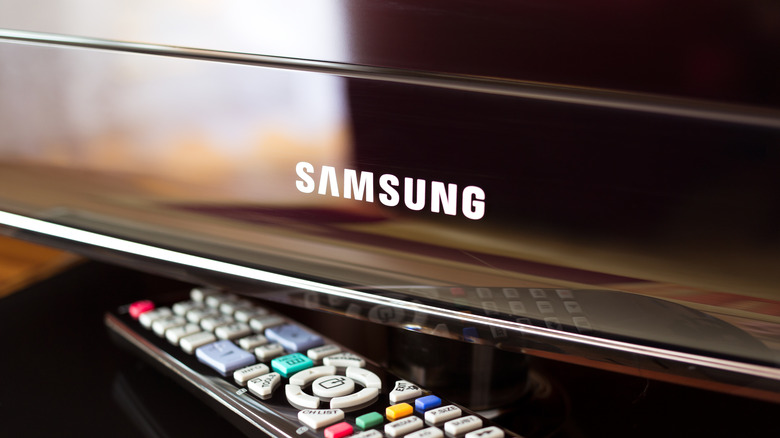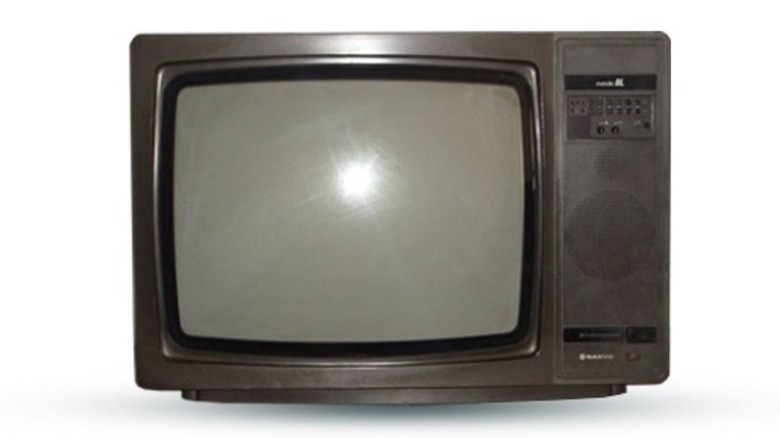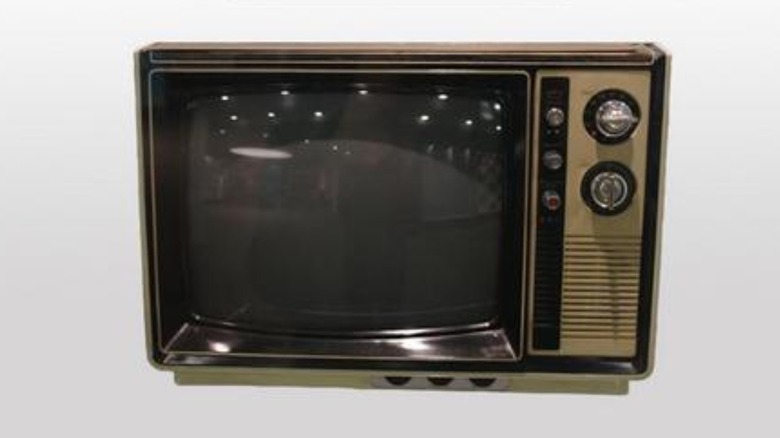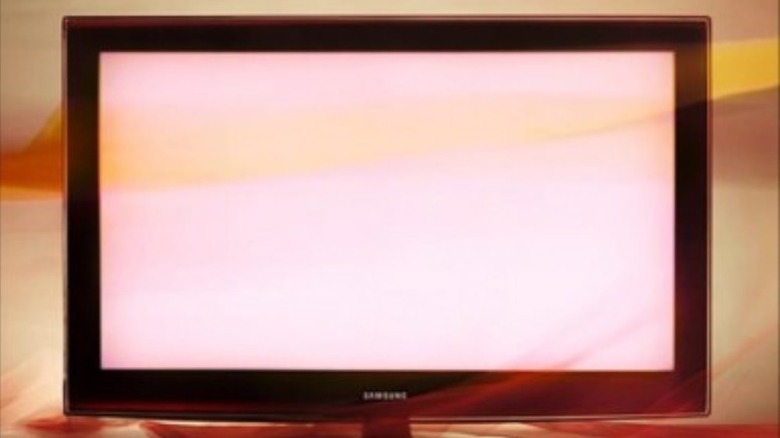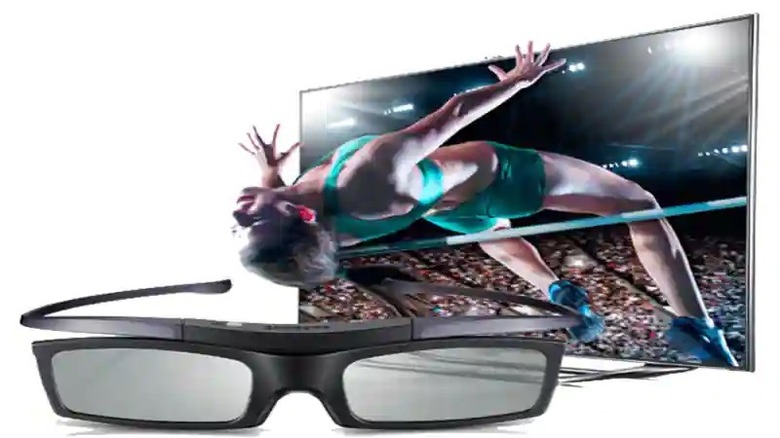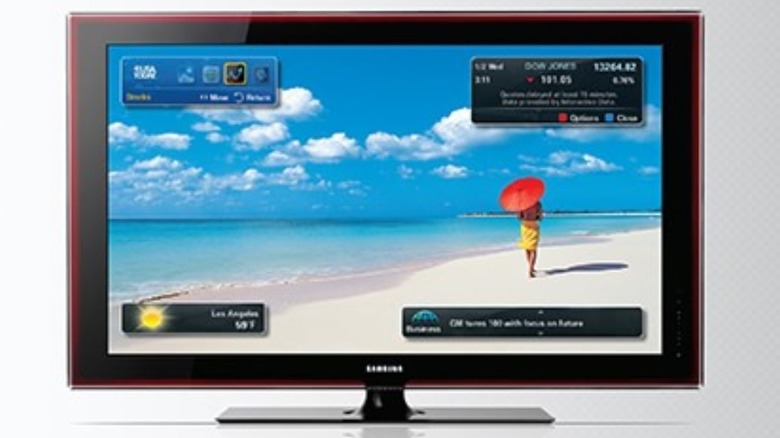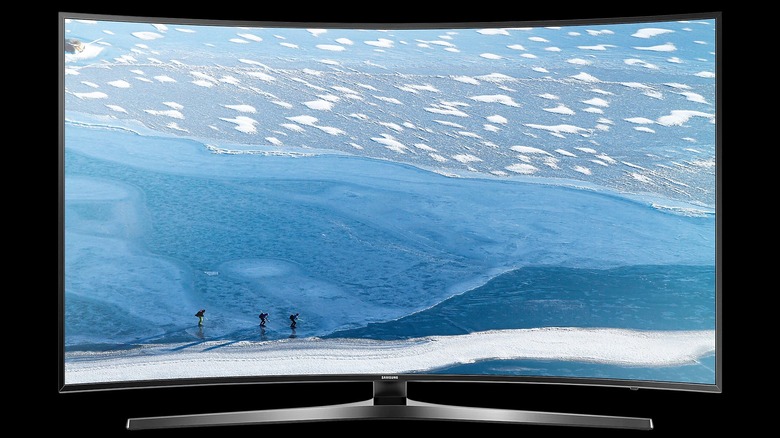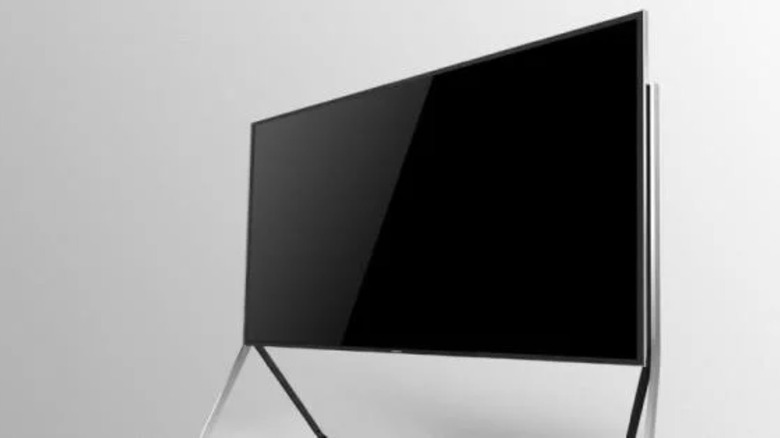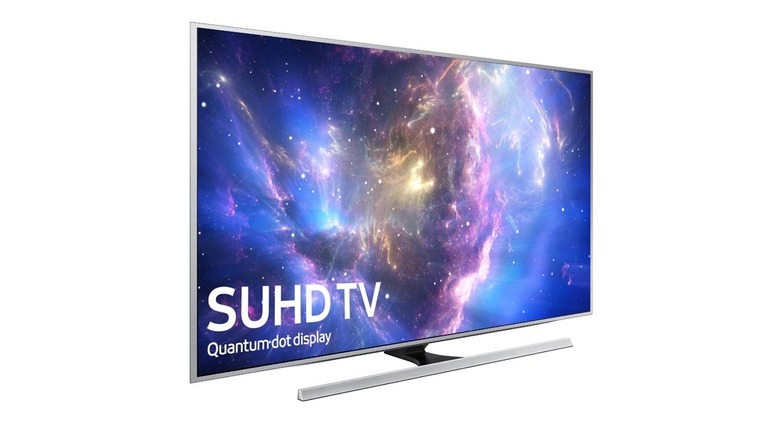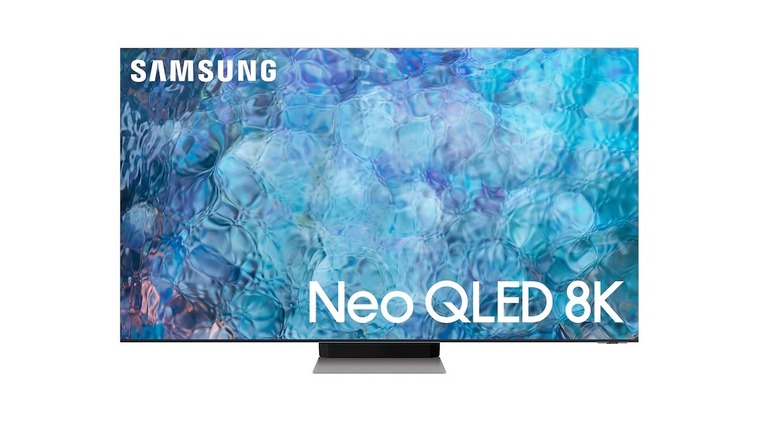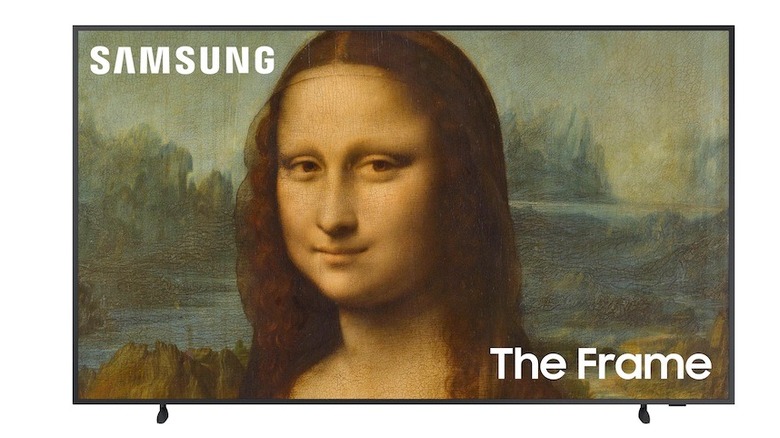The Transformation Of Samsung TV From 1970 To 2022
We may receive a commission on purchases made from links.
Over the last century or so, humanity has seen a revolution in the way we capture and share images. For thousands of years, the only way to catch a glimpse of something you didn't personally witness was to hope that a particularly talented artist would capture it and put it down on canvas.
Then, slowly and by degrees, photographic technologies allowed us to trap static images and fix them in place. Photography eventually evolved into motion pictures, by playing a series of still images in sequence and coupling them with sound. Suddenly images and experiences could be delivered to people all over the world, as long as they could make a trip to the theater.
In many ways, television was the final step in the evolution of visual technology, bringing news of the world and entertainment into the living rooms of billions of people. Television has come a long way since its introduction in the early twentieth century, and a lot of that innovation happened at Samsung.
From black and white vacuum tube sets to modern flat screens, Samsung has helped push the evolution of television technology to a point that their modern sets barely resemble those from only a handful of decades ago.
Samsung's first TV
Samsung got its start as a grocery trading company in Korea during the 1930s, with a focus on trading noodles within Korea's borders as well as exporting to China. After the Korean war, Samsung began a directed campaign of diversification which included an electronics division, (per Britannica).
On December 30, 1968, Samsung held an establishment meeting which would ultimately result in the creation of Samsung Electronics. The division was incorporated in January 1969 and almost immediately got to work developing black and white television sets.
Over the course of 1969, Samsung spun up its electronics division by partnering with other companies like NEC and Sumitomo and training up staff. It started releasing black and white televisions just in time for the new year, on December 23, 1969, (per Samsung).
Their 12-inch model, dubbed the P-3202, went on to sell millions of units in Korea and around the world over the next several years, establishing Samsung as a player in the global electronics market, (per Samsung Newsroom).
Samsung's first color TV
The introduction of color television once again revolutionized the industry. While color television was first delivered to consumers in 1954, (per Britannica), it would be another couple of decades before Samsung got in on the action, in 1977.
Of course, part of the delay was the fact that Samsung didn't start manufacturing televisions of any kind in earnest until 1970, but the major contributing factor to the additional seven-year delay was local economics and demand.
As late as the 1970s, there wasn't a single Korean television station which was broadcasting in color. As such, there wasn't really a market in Korea for color televisions, (per The Case Study Anthology). Before Samsung would start manufacturing a new product, they needed to be sure they were capable of exporting them to markets which would buy them.
In 1977, Samsung finally started producing their first color television, (per WorthPoint), and it became a successful successor to the P-3202. Five years later, they had sold a million color televisions and roughly 10 million black and white sets.
Flat panel plasma TV
As recently as a couple of decades ago, it wasn't uncommon for a television to take up a substantial amount of living room real estate. Bringing home a new TV meant rearranging furniture and might even have required purchasing additional furniture to support your display. TV stands and entertainment centers were built around the understanding that TV required a significant support system.
Despite continued improvements in picture quality, television manufacturers were running up against a physical limitation of the technology. Cathode-ray tubes needed space in order to produce the pictures which they'd project onto the screen. Then, seemingly all at once, things changed.
In 1998, Samsung began offering flat panel plasma TVs, (per Samsung Newsroom). Instead of the bulky CRT construction, plasmas worked by electrically exciting plasma between two flat planes of glass. In turn, the electrically excited plasma lights up pixels that contain the three primary colors. By lighting them up in varying ways, you can create complex pictures.
This shift in technology allowed for large displays which took up considerably less space. They could be mounted to a wall, instead of sitting on the floor or requiring an additional stand. There were downsides, however. The picture was dimmer, and images could burn into the screen over time, due to uneven activation of the phosphors, (per CNET). Burn in was a problem if you left DVD or video games playing, or if you played at a smaller aspect ratio with black bars at the edges.
Edge-lit LED
While consumers welcomed the slimmer design of plasma TVs, they were power hungry and had some significant downsides, as discussed above. Manufacturers, including Samsung, began looking for other ways to improve the technology while maintaining the reduced profile people had come to expect.
In 2009, Samsung released the first of their LED displays. As explained by CNN, in the first quarter of 2009, Samsung was losing market share to Vizio, which was offering televisions at a comparatively low price. The shift to LED gave Samsung an edge, if not in price, then in technology, which they hoped would help them recapture the top spot in global TV sales.
Their initial offerings were pricey, starting at $1,600, but they represented a significant jump forward. Overall, LED televisions allowed for even thinner screens, coming in at under half an inch in thickness, (per Engadget). The thinner a television can be made, the larger the display can be while keeping the same weight. Samsung's first LED TVs were offered in 40, 46, and 55-inch options. They also used about 40% less energy than their predecessors.
Despite the 2008 economic recession which was still ongoing at the time, the gambit worked, with Samsung selling 2.6 million LED TVs in 2009, (per Reuters).
HD 3D TV
While James Cameron claims that the success of the film was due to the story (per /Film), the common wisdom is that the stunning visuals and 3D technology was a significant contributor. Whatever the reason, the movie grossed nearly $3 billion dollars (per Box Office Mojo), making it the most successful film ever for a decade, and sparking the 3D movie craze like never before.
In 2010, Samsung set out to capitalize on the public's interest in 3D by bringing 3D movies and television into the home. Despite the large price tag, ranging from roughly $2,000 to $3,000 depending on the model, the TVs initially sold well. As explained by Yonhap News, Samsung sold more than a million sets in the first six months after launch.
The popularity of the technology eventually waned, driven in part by inherent limitations. Viewing in 3D required the use of glasses which needed either disposable batteries or frequent recharging, depending on how often they were used, (per CNET). Additionally, available 3D content was limited, despite the 2D to 3D conversion option.
As explained by Lifewire, that was just the beginning of why 3D TV didn't take off like Samsung and other manufacturers hoped. The additional equipment, costs, limited content, and the need to wear glasses were just too much for consumers to overcome after the novelty wore off.
Smart TV
It's difficult to imagine a world without Netflix and other streaming services, but they're relatively new services and the technology to bring them conveniently into your home is newer still. If you're old enough to remember the beginning of Netflix, you might remember placing movies into an online queue and waiting for DVDs to arrive in the mail. Later, in 2007, Netflix began offering the ability to stream content over the internet, (per Britannica).
For a while, streaming was largely accomplished using a desktop or laptop computer, but it was inevitable that streaming would eventually make its way to the television. In 2011, Samsung began offering Smart TVs with internet capabilities built in, (per Consumer Reports).
Initial models offered Samsung's Smart Hub to search for content. In addition to the remote, users could control their TVs using their smartphone or tablet. Some TVs even allowed you to stream content from the TV to a tablet, (per Flat Panels HD) and access the wider internet through a browser on your TV screen.
Shortly thereafter, Samsung integrated voice control and cloud storage. The ability to access content from streaming services like Netflix and Hulu changed the way viewers interacted with their televisions and drove innovations both in technology and content creation, (per Forbes).
Curved displays
If you've ever been to a dome show at a planetarium, you know the unique feeling of a visual experience which wraps around you. In 2013, Samsung attempted to duplicate that feeling, to a smaller degree, with the introduction of curved TVs.
Samsung claimed that curved TVs offered improved immersion, by virtue of the curved shape and enhanced 4K picture quality, (per Samsung Newsroom). It's difficult to argue that immersion would be improved, but the question of whether its significant enough to justify the price tag is still up for debate.
It's likely that the improved experience was driven more by the UHD (ultra high definition) 4k picture quality than from the curvature itself. Moreover, curving the screen necessarily subtracts from the low profile which had driven television innovation for the previous decade and a half.
Importantly, the picture could be distorted along the edges if you weren't sitting in the right place. Gaining the benefit of the curved screen required you sit fairly close to the television and as close to center as possible, (per Interesting Engineering).
That said, there's something intriguing about the curved display. They immediately catch the eye in any electronics showroom. Ultimately, all things being equal, the choice between a curved TV and a more conventional flat panel comes down to personal preference. If you like having the cool new thing, just for the sake of having it, a curved TV might be the right choice.
Bendable UHD
If you're unsure where you stand on the curved TV debate, Samsung has an option which lets you have the best of both worlds. In 2014, Samsung announced the release of an 85-inch UHD TV capable of transforming from a flat to a curved screen with the push of a button, (per Samsung Newsroom).
A collection of servo motors inside the TV itself control the movement in response to your commands. As explained by Cnet, Samsung designed the televisions to curve as much as possible, limited by the physics of the screen materials.
A year later, in 2014, Samsung released a larger 105-inch model with the same flexibility feature, (per The Verge). As with the statically curved TVs, the benefits seem to derive from the improved picture quality and not from the curvature itself. Which means when and if you tire of the curved display, you can set it back to standard and leave it. You'd have to be pretty psyched about the bendability to buy one, however. The initial price point was in the hundreds of thousands. You might be better off just buying a flat screen and a curved TV for separate viewing experiences.
SUHD
By 2016, ultra-high-definition TVs, more commonly known as 4k TVs, had become pretty ubiquitous. An increase in high definition content both on conventional TV channels, streaming, and home video, meant that HD became the standard for most new TV models. In an effort to maintain an edge on the competition, Samsung launched a lineup of SUHD TVs, (per Forbes).
At launch, it was unclear what the S in SUHD stood for. In fact, Samsung was pretty cagey about it. They have since revealed that it stands for "super" (per Samsung). Adding "super" as a modifier to picture definition which is already ultra-high, might seem superfluous, but what are you going to do?
While the basic technology behind SUHD is familiar, relying on LED-backlit LCD displays, they came with Samsung's version of "quantum dots," which is a fancy name for nanoparticles that expand the breadth of color your TV is capable of spitting out.
The nanoparticles range in size from 2 to 10 nanometers and emit a different wavelength of light depending on their size, (per Insights). The nanoparticles are embedded in a film sandwiched in the display. It offers a more robust color palette, higher definition, and won't age in the same way as OLED. Plus, quantum dots and nanoparticles just sound cool.
QLED and 8k
Moving into 2018, Samsung leaned hard into the quantum dot displays while many of its competitors had put their money down on OLED. Samsung branded quantum dot lineup under the name QLED, leveraging the sci-fi recognition that comes with anything quantum.
Samsung's commitment to QLED was evidence of their push toward improved picture quality, even if it meant a smaller piece of the market at first, as was the case in 2017, (per What Hi Fi).
Most of their initial QLED sets ran at 4k definition but it did allow Samsung to break into the 8k space in 2018. Their Q9SN model came in at 85 inches with native 8k resolution, which decreased the potential of noticing pixels when viewing such a massive display.
Of course, there was an inherent risk in launching an 8k TV before the rest of the world had caught up. There's little reason to buy one when there's hardly any content available, but Samsung thought of that. The Q9SN also came with a processing system that used artificial intelligence to convert 4k content to 8k, (per Forbes).
Anti-glare Frame
A big part of the evolution of television at Samsung and elsewhere has been all about doing more with less. Each new generation strives to provide better picture quality while taking up less space and using less energy. Despite that, as screens have grown in size, they've taken up more and more space on the wall. Oftentimes, entire walls in a living room or bedroom are dedicated to a TV.
Samsung's Frame TV offers consumers the option of having a gigantic TV without needing to look like you have a TV at all. These screens are designed to look like framed artwork when not in use, and you can even choose different frame styles to fit your desired aesthetic, (per Samsung).
While Samsung first announced the Frame TV in 2017, the original versions had a tendency to give themselves away through the glare which is typically present on TV and computer monitors when not in use. Starting in 2022, Samsung is offering a matte-display Frame that reduces glare and more convincingly creates the illusion of framed art, (per The Verge).
You can choose from a collection of preloaded images, including some of the world's most famous artworks, or you can upload your own images to make your Frame deeply personal. Each Frame also comes with a slim-fit wall mount which keeps the Frame flush against the wall.
